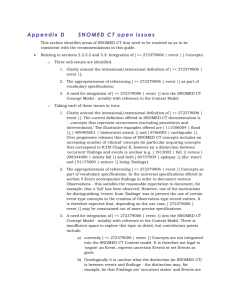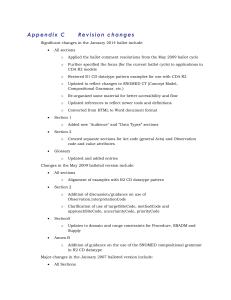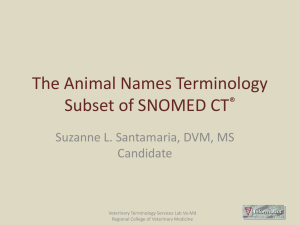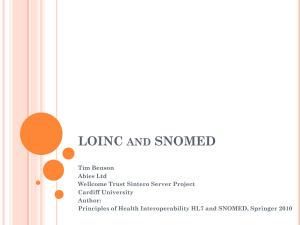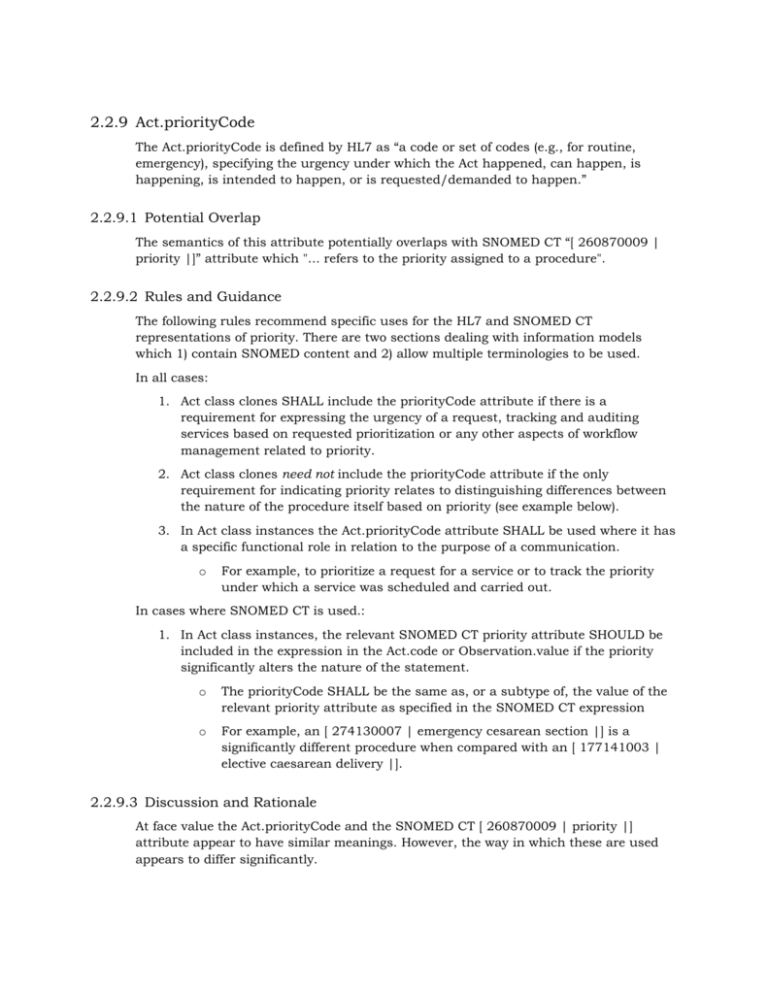
2.2.9 Act.priorityCode
The Act.priorityCode is defined by HL7 as “a code or set of codes (e.g., for routine,
emergency), specifying the urgency under which the Act happened, can happen, is
happening, is intended to happen, or is requested/demanded to happen.”
2.2.9.1 Potential Overlap
The semantics of this attribute potentially overlaps with SNOMED CT “[ 260870009 |
priority |]” attribute which "... refers to the priority assigned to a procedure".
2.2.9.2 Rules and Guidance
The following rules recommend specific uses for the HL7 and SNOMED CT
representations of priority. There are two sections dealing with information models
which 1) contain SNOMED content and 2) allow multiple terminologies to be used.
In all cases:
1. Act class clones SHALL include the priorityCode attribute if there is a
requirement for expressing the urgency of a request, tracking and auditing
services based on requested prioritization or any other aspects of workflow
management related to priority.
2. Act class clones need not include the priorityCode attribute if the only
requirement for indicating priority relates to distinguishing differences between
the nature of the procedure itself based on priority (see example below).
3. In Act class instances the Act.priorityCode attribute SHALL be used where it has
a specific functional role in relation to the purpose of a communication.
o
For example, to prioritize a request for a service or to track the priority
under which a service was scheduled and carried out.
In cases where SNOMED CT is used.:
1. In Act class instances, the relevant SNOMED CT priority attribute SHOULD be
included in the expression in the Act.code or Observation.value if the priority
significantly alters the nature of the statement.
o
The priorityCode SHALL be the same as, or a subtype of, the value of the
relevant priority attribute as specified in the SNOMED CT expression
o
For example, an [ 274130007 | emergency cesarean section |] is a
significantly different procedure when compared with an [ 177141003 |
elective caesarean delivery |].
2.2.9.3 Discussion and Rationale
At face value the Act.priorityCode and the SNOMED CT [ 260870009 | priority |]
attribute appear to have similar meanings. However, the way in which these are used
appears to differ significantly.
The SNOMED CT attribute is used to specify the defining characteristic that
distinguishes an elective procedure from an emergency procedure. Like any
defining attribute it can also be used to refine or qualify a procedure that is
specified without references to its urgency.
The HL7 priorityCode is generally used to communicate priority in relation to
workflow management and audit. One obvious use case for this is to allow
request for a service to indicate the priority assigned to it by the requester.
These aspects of priority can vary independently of one another. Two requests for the
same procedure can assert different priorities for processing them based on perceived
clinical need or other factors. On the other hand, some emergency procedures are
carried out directly without a specific request and thus without the normal workflow
associated with prioritization.
The use of a distinct information model attribute (i.e. Act.priorityCode), which is
applicable to all services, makes the priority more readily accessible to workflow
management. It does not require the SNOMED CT expression to be parsed to determine
the priority of a request or action. In addition, it allows consistent handling of priority
when some services are represented using SNOMED CT while others are represented
using different code systems.
The use of a representation of priority that is integrated with the definition model of the
associated concept is more useful from the perspective of clinical record retrieval. The
description logic model of SNOMED CT ensures the computational equivalence of a
procedure concept defined as an emergency and a post-coordinated expression in which
[ 260870009 | priority | = 25876001 | emergency |] is added to the more general
procedure concept.
2.2.10 Act.negationInd
The Act.negationInd is defined by HL7 as “An indicator specifying that the Act
statement is a negation of the Act as described by the descriptive attributes”.
NOTE: The Act.negationInd attribute has been deprecated in recent releases of the RIM
(since Sept. 2008) and has been replaced by the two new attributes of
Act.actionNegationInd and Observation.valueNegationInd (see Core Principles and
Properties of V3 Models for details). However, the original Act.negationInd has not been
deprecated and continues to be in use in CDA R2. It is anticipated that a future release
of CDA will update this to be consistent with the current RIM, but at present the
following guidance is applicable for the use of Act.negationInd in CDA R2.
2.2.10.1 Potential Overlap
The semantics of this attribute overlaps with:
SNOMED “[ 408729009 | finding context |]” values indicating absence of a
specified finding.
SNOMED CT “[ 408730004 | procedure context |]” values indicating that a
specified procedure was not done.
Page 2
HL7 V3 IG: TermInfo - Using SNOMED CT in CDA R2 Models, Release 1
© 2013 Health Level Seven International. All rights reserved.
January 2014
This overlap must be avoided. If not avoided, it leads to ambiguity. For example, a
combination of negationInd with a contextual representation of absence in SNOMED CT
results in different interpretations based on the approach taken, as:
double negation (i.e. "not finding X is absent" - which may mean "finding X is
present") [Note: Interpretations based on formal logic may not always be intuitive
for humans, and using machine reasoning in this way may have patient safety
implications.]
restatement or emphasis of the negative resulting from a mapping between the
two ways to indicate negation or absence (i.e. "negative observation: finding X is
absent" - which still means that "finding X is absent").
2.2.10.2 Rules and Guidance
The following rules avoid the risk of misinterpretation by prohibiting use of the
negationInd in Act class instances that are encoded using SNOMED CT.
1. In a constrained information model or template the negationInd attribute
SHOULD be omitted from:
o
any Act class clone in which SNOMED CT is the only permitted code
system for the Act.code attribute.
o
any Observation class clone in which SNOMED CT is the only permitted
code system for the Observation.value attribute.
2. In a constrained information model or template, the negationInd attribute
SHALL be optional if it is included in:
o
an Act class clone in which SNOMED CT is one of the permitted code
systems for the Act.code attribute.
o
any Observation class clone in which SNOMED CT is one of the permitted
code systems for the Observation.value attribute.
3. The negationInd attribute SHOULD be omitted from any Act class instance in
which the Act.code attribute is expressed using SNOMED CT.
o
Negative assertions about an Act (e.g. "procedure not done", "substance
not to be administered" ) SHOULD be represented, as part of the
SNOMED CT expression in the Act.code attribute, by including the
appropriate explicit [ 408730004 | procedure context |] (e.g. [ 385660001
| not done |] or [410521004 | not to be done |]).
4. The negationInd attribute SHOULD be omitted from any Observation class
instance in which the Observation.value attribute is expressed using SNOMED
CT.
o
Assertions of negative Observations (e.g. absence of a specified finding)
SHOULD be represented, as part of the SNOMED CT expression in the
Observation.value attribute, by including the appropriate explicit [
408729009 | finding context |].
5. The negationInd attribute MAY be included in an Act class instance where the
SNOMED CT expression represents a [ <<71388002 | procedure |] with no
explicit [ 408730004 | procedure context |] or a [ <<129125009 | procedure
HL7 V3 IG: TermInfo - Using SNOMED CT in CDA R2 Models, Release 1
Page 3
January 2014
© 2013 Health Level Seven International. All rights reserved.
with explicit context |] with [ 408730004 | procedure context | = 385658003 |
done |]
o
This approach is not recommended but is permitted to allow simple
negation in systems that do not support the SNOMED CT context model.
If it is used, it SHALL be interpreted as equivalent to the specified [
363589002 | associated procedure |] with [ 408730004 | procedure
context | = 385660001 | not done |].
6. The negationInd attribute MAY be included in an Observation class instance
where the SNOMED CT expression represents a [ <<404684003 | clinical finding
|] with no explicit [ 408729009 | finding context |] or a [ <<413350009 | finding
with explicit context |] with the [ 408729009 | finding context | = 410515003 |
known present |].
o
This approach is not recommended but is permitted to allow simple
negation in systems that do not support the SNOMED CT context model.
If it is used, it SHALL be interpreted as equivalent to the specified [
246090004 | associated finding |] with a [ 408729009 | finding context |
= 410516002 | known absent |].
7. If the negationInd attribute is present in an Act class instance in which either
the Act.code or Observation.value is expressed using SNOMED CT, it SHALL be
interpreted as an error unless the conditions noted in points 5 and 6 above
apply.
2.2.10.3 Discussion and Rationale
The Act.negationInd is an optional RIM attribute which negates the meaning of an Act.
This negation is unnecessary in cases where SNOMED CT is used because the context
attributes can be used to specify the absence of a finding or the fact that a procedure
has not been done. Including both representations introduces potential for serious
misinterpretation of combinations including the following:
Double negative
o
If negationInd is true and the SNOMED CT [ 408729009 | finding
context | = 410516002 | known absent |] the double negative would be
“not known absent” (i.e. “present”).
o
If negationInd is true and the SNOMED CT [ 408730004 | procedure
context | = 385660001 | not done |] the double negative would be “not
not done” (i.e. “done”).
o
For the avoidance of potential ambiguity this option is explicitly
prohibited by rules in this document.
Indication or emphasis of negation
o
HL7 negationInd indicates the presence of negation and the SNOMED CT
context provides more details of the nature of the negation.
o
Implies that if negationInd is true and the Act is coded with SNOMED CT
an appropriate negated SNOMED CT finding or procedure context value
Page 4
HL7 V3 IG: TermInfo - Using SNOMED CT in CDA R2 Models, Release 1
© 2013 Health Level Seven International. All rights reserved.
January 2014
(e.g. [ 410516002 | known absent |] or [ 385660001 | not done |])
should also apply.
o
Might imply that if a negated SNOMED CT finding or procedure context
value (e.g. [ 410516002 | known absent |] or [ 385660001 | not done |])
is applied the negationInd should be true.
Restatement of negation
o
HL7 negationInd and SNOMED CT negative contexts apply as
alternatives and when combined serve to restate the negation
o
Implies that if only negationInd is present a mapping table is required to
the relevant SNOMED CT context to enable consistent interpretation.
This mapping table would need to specify combinations of moodCode and
negationInd. For example, negationInd=true with moodCode=“EVN” the
would imply [ 408730004 | procedure context | = 385660001 | not done
|], whereas negationInd=true with moodCode=“RQO” might imply [
408730004 | procedure context | = 410521004 | not to be done |].
To meet requirements to support some simple negation in systems that do not support
the SNOMED CT context model, use of negationInd is permitted where it cannot be
misinterpreted. The only cases where no risk of misinterpretation are where the
SNOMED CT context is either unspecified or explicitly states the default values [
410515003 | known present |] or [ 385658003 | done |]. The negationInd can be used
to switch these defaults to the appropriate negated values such as [ 410516002 |
known absent |] and [ 385660001 | not done |].
2.2.11 Observation.interpretationCode
The HL7 RIM defines Observation.interpretationCode as:
A qualitative interpretation of the observation.
Examples: Normal, abnormal, below normal, change up, resistant.
Usage Notes: These interpretation codes are sometimes called "abnormal flags,"
however, the judgment of normalcy is just one of the interpretations, and is often not
relevant. For example, the susceptibility interpretations are not about "normalcy," and
for any observation of a pathologic condition, it does not make sense to state the
normalcy, since pathologic conditions are never considered "normal."
The value of including an observation interpretation is to be able to say:
(a) “The hemoglobin measurement is 18g/dl and this is abnormally high (when
compared with the reference range).”
or
(b) “This Streptococcus pneumoniae isolate has been tested for susceptibility to
Penicillin G and has been found to be resistant.”
2.2.11.1 Potential Overlap
There are multiple scenarios that may result in overlap, particularly with data recorded
in Observation.code or Observation.value.
1. Within HL7 V3
HL7 V3 IG: TermInfo - Using SNOMED CT in CDA R2 Models, Release 1
Page 5
January 2014
© 2013 Health Level Seven International. All rights reserved.
o
From a modeling perspective, the “interpretation” of a value (i.e.
laboratory test result, etc.) is an additional “higher level” observation that
is made on the results (raw data) from a particular investigation. This
additional observation can, and likely in some cases does, carry the full
semantics of an “observation” (including author, author time, etc.), and
thus may be represented by an additional instance of an Observation
class. Alternatively, and more commonly, the result of this additional
observation is represented using the interpretationCode attribute within
the original Observation class (which is essentially a lightweight or
“shortcut” method for representing this data). There is the potential for
conflict and/or ambiguity between these two approaches.
o
In some situations, current practice in V3 laboratory messaging (parallel
to the common usage in V2) has been to use the
Observation.interpretationCode in place of, rather than in conjunction
with Observation.value. This typically occurs in laboratory antimicrobial
susceptibility messaging (see the Streptococcus susceptibility to Penicillin
G example above).
2. Between HL7 V3 and SNOMED CT
o
The SNOMED CT concept model for Clinical Findings provides the
[ 363714003 | Interprets ] and [ 363713009 | Has interpretation ]
attributes. The latter represents similar notions to those intended
for use by the HL7 Observation.interpretationCode attribute. An
example of the use of these attributes is:
[ 165558001 | Platelet count abnormal ]
Includes, in its reference definition:
363714003 | Interprets |=61928009 | Platelet count |,
363713009 | Has interpretation |=263654008 | Abnormal |
o
Whether primitively represented or defined according to the above
scheme, SNOMED CT contains many pre-coordinated ‘Finding’
concepts, that include notions similar to those expressed as
‘interpretations’, for example:
[ 110368006 | Decreased estrogen level]
[ 102659003 | Normal glucose level ]
It is therefore possible to represent, using a SNOMED CT ‘Finding’
in Observation.value, notions such as ‘normality’, ‘abnormality’,
‘resistance’.
2.2.11.2 Rules and Guidance
Given the complexities described in ‘discussion and rationale’, it is not currently
possible to provide normative guidance on the use of Observation.interpretationCode. In
particular, it is not possible to provide guidance on the prohibition of
Page 6
HL7 V3 IG: TermInfo - Using SNOMED CT in CDA R2 Models, Release 1
© 2013 Health Level Seven International. All rights reserved.
January 2014
Observation.interpretationCode where SNOMED CT is the only permitted code system
for the Act.code.
However, the following guidance (with caveats) can be provided:
In a constrained information model or template that permits or requires the use
of SNOMED CT to represent the nature of an Observation class clone, or in
which SNOMED CT is one of the permitted code systems for the
Observation.value attribute, Observation.interpretationCode SHALL be optional.
In any Observation class instance in which the Act.code or Observation.value
attribute is expressed using SNOMED CT, and Observation.interpreationCode is
present, it shall take its value from the following range in SNOMED CT:
<<260245000 | findings values |
Unless explicitly specified by model designers or communicating parties,
SNOMED CT findings that represent ‘interpretation’ notions are not prohibited
from use. It is possible, therefore, that receiving systems and analytic queries
that wish to detect ‘interpretation’ notions may also need to test the SNOMED
CT concept carried as Observation.value.
2.2.11.3 Discussion and Rationale
Relevant to this topic, an HL7 Observation will currently support the representation of
three notions:
The thing being observed (in Observation.code)
The result of the observation (in Observation.value)
The interpretation of the result of the observation (in
Observation.interpretationCode)
Either primitively represented or modeled using the ‘has interpretation’ attribute,
SNOMED CT will support the representation of the following notions:
The thing being observed (in Observation.code)
The thing being observed and interpretation of the result of the observation (in
Observation.value)
There is therefore incomplete overlap in ‘interpretation’ representation, and incomplete
expressivity of SNOMED CT to support all aspects of representation (a SNOMED CT
expression cannot exhaustively communicate the result of an observation and its
interpretation).
Evidence suggests that Observation.interpretationCode is currently used, and it is not
possible currently to provide a SNOMED CT-only representation to allow its prohibition.
Neither is it possible, currently, to enhance normalization rules to support equivalence
detection between ‘interpretations’ communicated in Observation.value or in
Observation.interpretationCode.
HL7 V3 IG: TermInfo - Using SNOMED CT in CDA R2 Models, Release 1
Page 7
January 2014
© 2013 Health Level Seven International. All rights reserved.
2.2.12 Representation of Units
The HL7 Observation.value attribute allows units to be applied to a physical quantity,
range or ratio. The HL7 datatypes specification requires the use of UCUM (Unified Code
for Units of Measurei) to express units in the PQ (physical quantity) datatype.
2.2.12.1 Potential Overlap
SNOMED CT contains concepts that represent most of the widely used units and these
overlap with the UCUM representation. These SNOMED CT concepts could be
represented in the translation element of the PQ datatype. However, this would
introduce redundancy and the potential for conflict between the alternative
representations.
2.2.12.2 Rules and Guidance
The following guidance is intended to reduce the need for redundant representation of
units and maximize the opportunity for automated unit conversion.
1. Consistent with the Data Types: Abstract specification (both the R1 release, as
used in CDA R2, and the R2 release), the unit attribute of the HL7 PQ (physical
quantity) data type SHALL be encoded using the appropriate UCUM
representation and not using a SNOMED CT concept identifier.
a) If a SNOMED CT concept identifier is used to populate the unit attribute
of the PQ data type, this is a non-standard use which will result in an
invalid CDA R2 or V3 instance.
b) It is valid in CDA R2 and V3 to use a SNOMED CT concept identifier to
populate the translation element of the PQ data type, but this is not
recommended in cases where a standard UCUM representation exists, in
order to avoid introducing redundancy and the potential for conflict
between the alternative representations.
2. In the case of “informal units", which have no standard UCUM representation, a
SNOMED CT concept identifier MAY be used in the translation element of the PQ
data type.
2.2.12.3 Examples of “informal units" may include counted items (such as tablets or
capsules). Items such as these are frequently encountered in the role of a
"unit", but are not true units at all (as they include dose form or other
information). The use of these “informal units", although common, is
discouraged. The nature of the counted items should be captured in the
appropriate information model or terminology structures. In these cases the
unit "1" (the UCUM symbol meaning "the unity") or the "informal unit"
enclosed in curly braces ({}) SHALL be used and the SNOMED CT
representation of the nature of the counted unit MAY then be used in the
translation element.Discussion and Rationale
Use of UCUM representation simplifies interoperability using HL7 messages. The UCUM
specification also supports translation between different types of units. It is possible to
map from SNOMED CT concepts to UCUM in all cases except those where an informal
Page 8
HL7 V3 IG: TermInfo - Using SNOMED CT in CDA R2 Models, Release 1
© 2013 Health Level Seven International. All rights reserved.
January 2014
unit is specified. On the other hand, since the UCUM representation is an expression
syntax it can be used to represent an almost unlimited range of complex units in a
formal mathematical manner. Many of the units that can potentially be represented in
UCUM have no pre-coordinated equivalent in SNOMED CT. SNOMED post-coordination
does not currently support the type of mathematical formalism that UCUM offers.
2.2.13 Dates and Times
In the RIM the HL7 Act class includes two attributes related to the temporal situation of
an action (Act.effectiveTime, Act.activityTime). In CDA R2 this has been constrained to
allow only the effectiveTime attribute.Each participation in an Act may also have an
associated time (for example, author.time or performed.time). Each of these times can
be expressed either as a point-in-time or a period of time.
2.2.13.1 Potential Overlap
The SNOMED CT [ 408731000 | temporal context |] distinguishes between findings or
procedures that are recorded as part of "past" history and those that are recorded as [
15240007 | current |]. It also allows a distinction to be made between a specified point
or period in time (e.g. and a more general unspecified time (e.g. [ 410588008 | past unspecified |]). The [ 408731000 | temporal context |] potentially affects the
interpretation HL7 date and time attributes.
When a SNOMED CT expression (or concept definition) includes an explicit
representation of [ 408731000 | temporal context |], the effectiveTime might be
interpreted either as "the time at which the situation applied" or "the time at which the
focus concept applied". Guidance is needed to avoid this potentially misleading
ambiguity.
o
o
For example, the definition of the concept [407553003 | history of glandular fever |] includes:
[ 246090004 | associated finding | = 271558008 | glandular fever |,
408731000 | temporal context | = 410513005 | past |]
The concept [407553003 | history of - glandular fever |]
represents a situation.
The value of the associated finding attribute is the focus concept
(i.e. the concept [ 271558008 | glandular fever |]).
When an Observation asserts the value [407553003 | history of glandular fever |], the effectiveTime might be interpreted as:
The time when the focus concept applied (i.e. the time in the past
when they actually had glandular fever);
The period of time during which the situation applied (i.e. the
period of time during which they had a "history of glandular fever"
(i.e. a period of time from when they first had glandular fever with
no upper bound or extending until death);
HL7 V3 IG: TermInfo - Using SNOMED CT in CDA R2 Models, Release 1
Page 9
January 2014
© 2013 Health Level Seven International. All rights reserved.
The time during an episode of care when the situation was
recognized (i.e. a period starting when "history of glandular fever"
was first recorded as part of the record of this episode of care);
The time during which the situation was considered clinically
relevant (i.e. a period of time based on a clinical judgment of the
significance of a past history of glandular fever to the currents
longer term health).
2.2.13.2 Rules and Guidance
The following rules clarify the impact of [ 408731000 | temporal context |] on
interpretation of HL7 date and time attributes associated with an Act class instance.
1. If a SNOMED CT expression includes an explicit [ 408731000 | temporal context
|] value, the effectiveTime SHALL be interpreted as applying to the time at which
the focus concept applied.
o
The focus concept is the value of the [ 246090004 | associated finding |]
or [ 363589002 | associated procedure |] in the SNOMED CT expression
or concept definition.
For example, the Act.effectiveTime for [ 407553003 | history of glandular fever |] is the time, in the past, when they had
glandular fever.
o
If the [ 408729009 | finding context |] indicates negation (e.g. [
408729009 | finding context | = 410516002 | known absent |]), the
Act.effectiveTime refers to the point in time or period or time during which
the focus concept was known to be absent
o
Similarly, if the [ 408730004 | procedure context |] has a negative value
such as [ 385660001 | not done |] the Act.effectiveTime refers to the
point in time or period or time during which the focus concept was not
done.
For example, the Act.effectiveTime for [ 165139002 | endoscopy
not carried out |] represents the time at which, or period during
which, an endoscopy was not done.
2. If the SNOMED CT expression in an Act class instance specifies [ 408731000 |
temporal context | = ([ 410584005 | current - specified |) OR ( 410587003 |
past - specified |)]:
o
the Act.effectiveTime attribute SHALL be present and its value SHALL be
interpreted as the clinically relevant point or period in time at which the
focus concept applied or is intended to apply.
3. If the SNOMED CT expression in an Act class instance does not explicitly specify
[ 408731000 | temporal context |] or explicitly specifies [ 408731000 | temporal
context | = ( 410512000 | current or specified |) OR ( 15240007 | current |) OR
([ 410585006 | current - unspecified |)]:
o
the Act.effectiveTime attribute SHOULD be included and, if present, its
value SHALL be interpreted as the clinically relevant point in time or
Page 10
HL7 V3 IG: TermInfo - Using SNOMED CT in CDA R2 Models, Release 1
© 2013 Health Level Seven International. All rights reserved.
January 2014
period during which the associated finding procedure applied or is
intended to apply.
o
If the Act.effectiveTime represents a period of time with an upper
bound either set in the future or omitted, this indicates that the
focus concept continues (or is expected to continue) to apply
beyond the time when it was recorded.
If the Act.effectiveTime attribute is omitted (or contains a null flavor), the
Participation.time value stated for a performer MAY be regarded as an
approximation to the clinically relevant time.
4. If the SNOMED CT expression in an Act class explicitly specifies [ 408731000 |
temporal context | = ((410513005 | past |) OR ( 6493001 | recent |))]:
o
the Act.effectiveTime attribute MAY be included and, if present, its value
SHALL be interpreted as the clinically relevant point or period in time to
which the focus concept applied or is intended to apply.
o
the Participation.time value stated for an author SHALL be regarded as
the time at which it was asserted that this procedure or observation was
carried out in the past.
5. If the SNOMED CT expression in an Act class instance explicitly specifies [
408731000 | temporal context | = 410588008 | past - unspecified |]:
o
the Act.effectiveTime attribute SHALL NOT be included as this would
contradict the asserted [ 408731000 | temporal context |].
o
the Participation.time value stated for an author SHALL be interpreted as
the time at which it was asserted that this procedure or observation was
carried out in the past.
6. If the SNOMED CT expression in an Act class explicitly specifies [ 408731000 |
temporal context | = 410589000 | all times past |]:
o
the Act.effectiveTime attribute SHOULD NOT be included but, if present, it
SHALL only specify the upper bound of a period of time.
o
Note: The [ 408731000 | temporal context | = 410589000 | all
times past |] is used with [ 408729009 | finding context | =
410516002 | known absent |] to assert a negative past history or a
negative family history (e.g. [ 266882009 | no family history of
ischemic heart disease |]). Negative assertions of this type imply
that at [ 410589000 | all times past |] the focus concept did not
apply. It is reasonable to combine this with the upper bound of a
period of time, as the finding may be true at some future point in
time (e.g. the patient may now be diagnosed as having asthma,
although they have no past history of asthma). However, it would be
contradictory to specify a point in time value or a lower bound for a
period of time.
the Participation.time value stated for an author SHALL be interpreted as
the time at which it was asserted that at all times past this Observation
applied.
HL7 V3 IG: TermInfo - Using SNOMED CT in CDA R2 Models, Release 1
Page 11
January 2014
© 2013 Health Level Seven International. All rights reserved.
2.2.13.3 Discussion and Rationale
In most cases, following the general rules specified by the HL7 RIM allow unequivocal
interpretation of the meaning of the Act.effectiveTime and associated Participation.time
values. However, there are several possible interpretations of Act.effectiveTime, in
relation to a SNOMED CT expression which includes an explicit past history temporal
context (i.e. [ 408731000 | temporal context |<< 410513005 | past |]). Therefore, the
rules specified above require that the relative time as specified by the SNOMED CT [
408731000 | temporal context |] and any specific point or period of time expressed in
Act.effectiveTime should be consistent with one another. The rules do not permit the
effectiveTime and [ 408731000 | temporal context |] to be interpreted in a
combinatorially manner. Thus if the [ 408731000 | temporal context | = 410513005 |
past |] the Act.effectiveTime, if stated, must be the point or period in the past when the
finding applied.
i
http://aurora.rg.iupui.edu/UCUM
Page 12
HL7 V3 IG: TermInfo - Using SNOMED CT in CDA R2 Models, Release 1
© 2013 Health Level Seven International. All rights reserved.
January 2014

